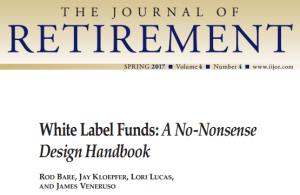“White label” funds are investment structures built using a mix of underlying funds to provide a simple but rich multi-manager exposure to an asset class. Their intuitive labeling (i.e., “Company XYZ Small Cap Fund”) is designed to help participants easily understand the role of a specific fund in a portfolio. White label structures also help plan administrators swap out underperforming funds without upsetting brand-loyal participants.
In a paper I wrote with my colleagues Jay Kloepfer, Lori Lucas, and Jimmy Veneruso for The Journal of Retirement, “White Label Funds: A No-Nonsense Design Handbook,” we offer a guide to plan sponsors considering adding these funds to their lineup.
Callan believes these structures are an important breakthrough for fiduciaries of large defined contribution (DC) plans committed to providing their participants with actively managed investment options.
In the paper, we provide a guide to developing white label funds, as well as exploring the considerations plan sponsors must evaluate in deciding whether to offer them.
White label funds, we write, are for DC plans that wish to make active management available to participants. White label funds are intended to replace single active fund options with a well-designed blend of strategies that offer what we believe is the best approach to gaining active management exposure to a particular asset class. These funds may include a judicious blend of active and passive mandates.

Fiduciaries for DC plans with assets over $500 million typically can find the scale to justify the expense of fund unitization, depending on the asset class. Smaller DC plans with service providers equipped to offer less-expensive model portfolio accounting can also consider white label fund structures.
The security selection methodologies inside a white label fund can be active, passive, or both. The internal vehicle structures can include mutual funds, collective trusts, or separate accounts. The fund can contain a mix of vehicles and security-selection strategies. Plan fiduciaries are responsible for selecting the fund managers and allocating assets to them, as well as the necessary disclosure and monitoring duties typically involved with a plan’s investment options.
White label funds can simplify the fund lineup, reducing an array of individual manager options to a handful of thoughtfully designed asset class building blocks. We believe the DC plan menu below strikes a balance between a) access to diversification options and b) the prudence of anticipating the “user error” of participants who spread their assets evenly across a menu of investment options:
- Capital preservation
- Fixed income
- Diversified real assets
- Large cap U.S. stock
- Broad non-U.S. stock
- Smid cap U.S. stock
While the underlying makeup of a multi-manager fund deserves careful attention, deciding how to set the fund up is a crucial step. Solutions range from utilizing a recordkeeper’s platform to build model portfolios, to having the trust/custody provider unitize the funds to create custom accounts. Newer approaches involve creating a customized collective trust or a private mutual fund.
Participant communications are also important for white label funds. First, key disclosures must be produced and distributed for custom funds, the same as for retail funds. Second, sponsors should clearly communicate fund roles and expectations up front so participants start off on the right foot.
In our view, the additional resources and effort to unlock the benefits of white label funds is often worth it. They can solve a capacity problem with current fund options, shape the choices for participants to a safer range without sacrificing quality, capitalize on access to a good low-cost defined benefit plan manager, or correct expense issues that are the focus of lawsuits.
White label funds can simplify the fund lineup, reducing an array of individual manager options to a handful of thoughtfully designed asset class building blocks.

